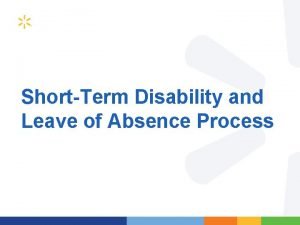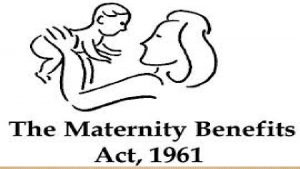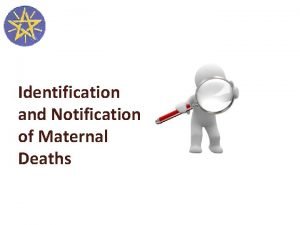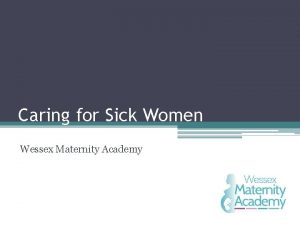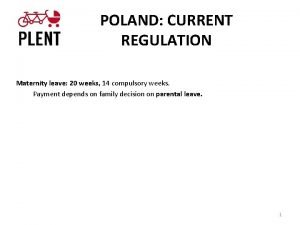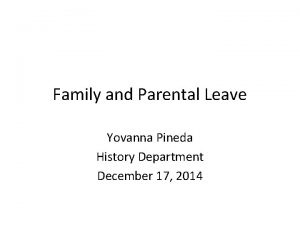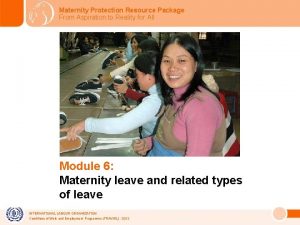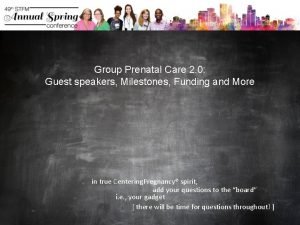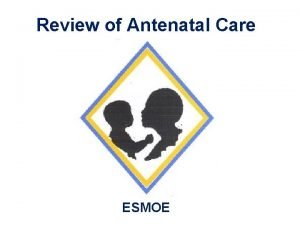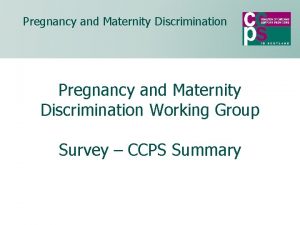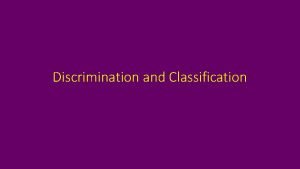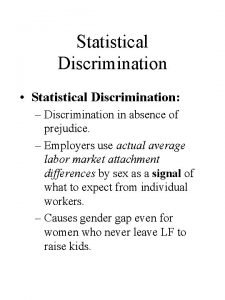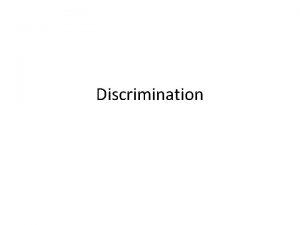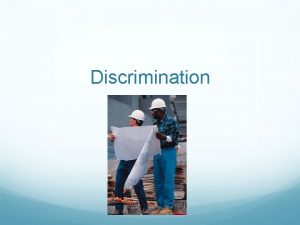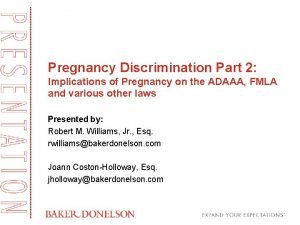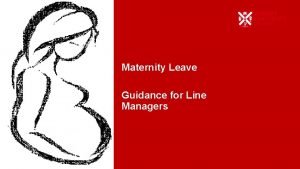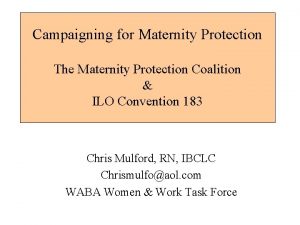Pregnancy and Maternity Discrimination Overview Pregnancy and Maternity












- Slides: 12

Pregnancy and Maternity Discrimination: Overview

Pregnancy and Maternity Discrimination Update and information gathered: Summary of outcome from survey process, key concerns and suggestions/feedback so appropriate actions can be considered

• • • Overview- process Initial survey Follow up Targeted additional survey feedback sought Discussion & survey focus groups Summarise outcome from process, key concerns and suggestions/feedback so appropriate actions can be considered Generally a positive picture in terms of approach in the sector Specific concerns are highlighted In total just under 50 organisations/participants engaged in this process

Greatest concerns • Three highest concerns over Mat Leave: • Woman pregnant or on Mat Leave request to work changed hours on return to work • Costs of Mat Pay not affordable • Costs of providing Mat Leave cover not affordable

Return from maternity leave • Very low non return rate of women following maternity leave Qualitative information confirmed this was not a big area of concern and some anecdotal thoughts were that there may be a delayed staff turnover i. e. mothers that return following maternity period for a while but leave later

• Top 3 difficulties facing employers: • • • Levels of sickness absence for those returning from maternity leave Managing workloads for other members of the team Pregnancy among those on short or fixed term contracts/appointment Generally participants indicated that it is relatively easy to facilitate required changes to duties and to facilitate maternity leave

• Biggest areas of issue: • Accumulation of annual leave during maternity leave • Right to request Flexible Working

• Efforts to grant requests are genuine. It appears flexible working request issues are due to the nature of the sector for the following reasons: • Burden on service and staff • Moves duty focus to times outside of Service User (SU) ‘need times’ • Rotas make it hard to accommodate requests for working set days • The impact on the people being supported • Unrealistic and high expectations of returners • Insufficient work available • Clash with service agreements/operational reasons • Recruiting issues

• External advice is being sought with 56% looking for advice on (in order of frequency): • • • Flexible working Shared Parental leave Redundancy Risk assessments Long term sickness absence/capability and dismissal

Some qualitative feedback: • Flexible working an issue for our sector- not due to lack of information or intent , but it is a resourcing issue and also the way that social care/voluntary sector services are designed and delivered. • Reduced cost/tax breaks for availability of flexible and good quality child care, would be welcome and helpful rather than additional maternity information for the sector. • Changes or improvements to guidance on pregnancy and maternity issues for 3 rd Sector organisations is welcome- a single point of access would be helpful. • Rather than developing a sector ‘plan’, because the practice and approach appears relatively positive, a more balanced action may be keeping M&P discrimination on forum agendas and mutual good practice sharing going.

Suggestions/actions: • • 84% are in favour of a fund to help 3 rd Sector reclaim SMP Focus groups explored: Mutual support and clarification within the sector around SMP reclaim can be offered informally 72% are in favour of an initiative to help 3 rd Sector employers enhance practices in relation to maternity and pregnancy Focus groups explored: Internet single point of access for relevant info and good practice would be beneficial. Sector is no different from other sectors in that initiatives to enhance practices are welcome. Good practice can be shared and examples suggested by participants: • Risk Assessments • Trial periods for flexible working requests • KIT, including Mat Leave staff in training, info for vacancies, etc. • Enhanced Mat Pay based on minimum attendance/service • Inclusive approach with support, person centred Focus groups explored: Good practice can and is being shared in the existing networks and forums. Raise topic at intervals in the larger forums. CCPS consider repeating the survey process in 2020/21 to see if there has been any change or there any emerging areas of concern/ new potential actions CCPS continue to be represented on the Scottish Pregnancy and Maternity Discrimination Working Group

A footnote Similar to other sectors, the tracking of actual data for employees is difficult around this topic because pregnancy is a transient state and not a characteristic that can be recorded in the same way as most other protected characteristics (i. e. your ethnic origin won’t change for example and is usually recorded from recruitment stage) • It is therefore a challenge to get facts/accuracy in reporting from organisations and questions/discussions tends to be around perception, view and ‘approximately’ • This put some people off providing information (estimating with knowledge but not necessarily having the data to hand/retrieving it taking significant time or not being possible) • It may be better either to adapt the survey process to take this further into account or support providers to discuss and consider how they might provide ‘temporary trackers’ within their information collection and recording systems should they wish to achieve greater accuracy in reporting •
 Molar pregnancy symptoms
Molar pregnancy symptoms Walmart sedgwick maternity leave
Walmart sedgwick maternity leave Ar 600-8-10 maternity leave
Ar 600-8-10 maternity leave Legislation related to maternity benefits
Legislation related to maternity benefits Objectives of maternity ward
Objectives of maternity ward Wessex maternity academy
Wessex maternity academy Maternity leave poland
Maternity leave poland Early obstetric warning system chart
Early obstetric warning system chart Ut austin maternity leave
Ut austin maternity leave Why is maternity leave important
Why is maternity leave important Maternity bitmoji
Maternity bitmoji Maternity benefit act 1961 notes
Maternity benefit act 1961 notes Antenatal assessment format
Antenatal assessment format

